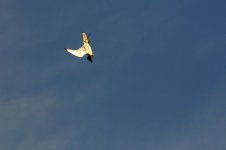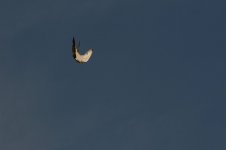You are using an out of date browser. It may not display this or other websites correctly.
You should upgrade or use an alternative browser.
You should upgrade or use an alternative browser.
Bird Photography
- Thread starter markimage
- Start date
- Messages
- 8,029
- Name
- Bazza
- Edit My Images
- Yes
First of all are you talking about birds in flight or perched on something
what distance are you photographing birds at? if right in front of the lens all you get is blur big time, further away this doesnt happen so much. also shutter speed has to be considered. to "freeze" a bird in flight 1/8000 sec is what I use. Next are you panning the bird as it flies along or is it just going past the lens, you don't say

If you have a bird of prey centre near you that is a good place to go practice. that is what I often did when I lived in the Midlands. the demonstration flights are predictable .
hope this helps in some way
what distance are you photographing birds at? if right in front of the lens all you get is blur big time, further away this doesnt happen so much. also shutter speed has to be considered. to "freeze" a bird in flight 1/8000 sec is what I use. Next are you panning the bird as it flies along or is it just going past the lens, you don't say

If you have a bird of prey centre near you that is a good place to go practice. that is what I often did when I lived in the Midlands. the demonstration flights are predictable .
hope this helps in some way
Last edited:
- Messages
- 9,619
- Name
- Steve
- Edit My Images
- Yes
With practice, decent shots are possible on most systems. I used to shoot Canon (7D2 & 6D) with a sigma 150-600 but I found the outfit a bit too heavy for me and I moved to Fuji, I currently have an X-T3 which isn't great for this sort of stuff but I make do, shooting with a 100-400, sometimes with a 1.4TC. The issue with the TC is that my fastest aperture is then f8, combined with British weather, means I'm shooting at 1600 or 3200 ISO.
So, as Bazza mentioned, it depends on what you are going to shoot, at what distance, and whether they're perched or flying. Like I said, in flight shots are possible with practice, and a local falconry display is a good start. If you know where Herons may be found, they are big and slow, so again good practice. Other than that, you can try shooting local garden birds but they tend to be quick and small
This was a bit of a lucky one for me, shot on the Fuji gear near my house.
 Barn Owl2 by Steve Jelly, on Flickr
Barn Owl2 by Steve Jelly, on Flickr
So, as Bazza mentioned, it depends on what you are going to shoot, at what distance, and whether they're perched or flying. Like I said, in flight shots are possible with practice, and a local falconry display is a good start. If you know where Herons may be found, they are big and slow, so again good practice. Other than that, you can try shooting local garden birds but they tend to be quick and small

This was a bit of a lucky one for me, shot on the Fuji gear near my house.
 Barn Owl2 by Steve Jelly, on Flickr
Barn Owl2 by Steve Jelly, on Flickr- Messages
- 493
- Edit My Images
- Yes
Beautiful shot!First of all are you talking about birds in flight or perched on something
what distance are you photographing birds at? if right in front of the lens all you get is blur big time, further away this doesnt happen so much. also shutter speed has to be considered. to "freeze" a bird in flight 1/8000 sec is what I use. Next are you panning the bird as it flies along or is it just going past the lens, you don't say

If you have a bird of prey centre near you that is a good place to go practice. that is what I often did when I lived in the Midlands. the demonstration flights are predictable .
hope this helps in some way
- Messages
- 493
- Edit My Images
- Yes
Beautiful!With practice, decent shots are possible on most systems. I used to shoot Canon (7D2 & 6D) with a sigma 150-600 but I found the outfit a bit too heavy for me and I moved to Fuji, I currently have an X-T3 which isn't great for this sort of stuff but I make do, shooting with a 100-400, sometimes with a 1.4TC. The issue with the TC is that my fastest aperture is then f8, combined with British weather, means I'm shooting at 1600 or 3200 ISO.
So, as Bazza mentioned, it depends on what you are going to shoot, at what distance, and whether they're perched or flying. Like I said, in flight shots are possible with practice, and a local falconry display is a good start. If you know where Herons may be found, they are big and slow, so again good practice. Other than that, you can try shooting local garden birds but they tend to be quick and small
This was a bit of a lucky one for me, shot on the Fuji gear near my house.
Barn Owl2 by Steve Jelly, on Flickr
- Messages
- 4,348
- Name
- Martin
- Edit My Images
- Yes
Just found this thread.
I went out to day with my new Sigma 60-600mm with the intention of getting flying bird shots near the seaside and I did indeed see lots of flying birds. One thing I learned, photographing flying birds is hard! I think I need a lot more practice as I took 179 pictures and ended up with nine that I kept -- none of which are of flying birds!
I made a couple rookie mistakes that I discovered afterwards, notable of which was that I fell into the shutter speed/focal length formula and only used a SS of about 1000/sec, perhaps 2000 on occasions -- not fast enough. I also had my exposure mode set to matrix and I was taking pictures of white little egrets at distance against a dark green background and accordingly I burnt out all my highlights! God, I'm rubbish at this. Here are some of of the dubious results:
This heron has camera shake and the whites on its neck are burnt out despite the best efforts of Lightroom.
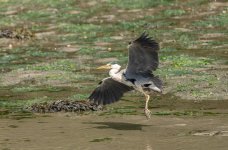
This could almost have been a good picture but again the shutter speed was too slow and its back has no detail
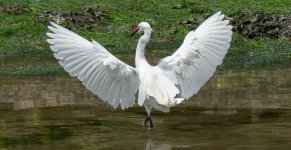
Seagull's head. Not too bad this one, if a bit flat.
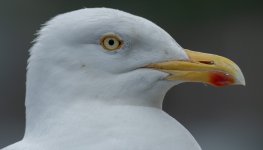
Another non-flying bird, I think it's a juvenile black-headed gull
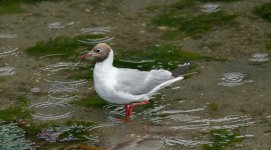
Egret, with the highlights reduced as much as LR could go
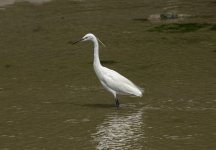
I quite like this, it's like a seagull air show with two spectators
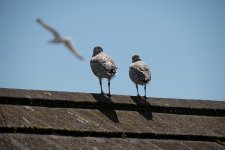
I went out to day with my new Sigma 60-600mm with the intention of getting flying bird shots near the seaside and I did indeed see lots of flying birds. One thing I learned, photographing flying birds is hard! I think I need a lot more practice as I took 179 pictures and ended up with nine that I kept -- none of which are of flying birds!
I made a couple rookie mistakes that I discovered afterwards, notable of which was that I fell into the shutter speed/focal length formula and only used a SS of about 1000/sec, perhaps 2000 on occasions -- not fast enough. I also had my exposure mode set to matrix and I was taking pictures of white little egrets at distance against a dark green background and accordingly I burnt out all my highlights! God, I'm rubbish at this. Here are some of of the dubious results:
This heron has camera shake and the whites on its neck are burnt out despite the best efforts of Lightroom.

This could almost have been a good picture but again the shutter speed was too slow and its back has no detail

Seagull's head. Not too bad this one, if a bit flat.

Another non-flying bird, I think it's a juvenile black-headed gull

Egret, with the highlights reduced as much as LR could go

I quite like this, it's like a seagull air show with two spectators

- Messages
- 4,348
- Name
- Martin
- Edit My Images
- Yes
Further to my admission of my mistakes above, I have found some more:
I used back-button focussing but it would seem that in birds-in-flight photography benefits from using the shutter button in its default mode.
Since I should be using high shutter speeds, I should turn off OS (/VR, IS, whatever flavour of camera you have).
If I'm wrong in any of my ideas here, feel free to let me know, but my intended changes do seem to make sense; I'll find out tomorrow as I'm going back to the little egrets to try again.
I used back-button focussing but it would seem that in birds-in-flight photography benefits from using the shutter button in its default mode.
Since I should be using high shutter speeds, I should turn off OS (/VR, IS, whatever flavour of camera you have).
If I'm wrong in any of my ideas here, feel free to let me know, but my intended changes do seem to make sense; I'll find out tomorrow as I'm going back to the little egrets to try again.
- Messages
- 17,355
- Name
- Bob
- Edit My Images
- Yes
Why?I used back-button focussing but it would seem that in birds-in-flight photography benefits from using the shutter button in its default mode.
I've always found it easier using bbf
Last edited:
- Messages
- 4,348
- Name
- Martin
- Edit My Images
- Yes
Why?
I've always found it easier using bbf
I don't know, it's just something I read and it seems like it might be reasonable as I suppose the camera might be a little more stable if only one button is being pressed rather than two. I always use BBF in normal use.
sk66
Advertiser
- Messages
- 8,716
- Name
- Steven
- Edit My Images
- Yes
There is no inherent advantage to BBF for action photography. BBF has the ability to immediately switch between manual focus (don't touch the button), single focus (press/release), and continuous focus (press/hold)... but there's other ways to do the same just as easily. And it has the ability to separate metering from focus... which I find to be of questionable benefit.I don't know, it's just something I read and it seems like it might be reasonable as I suppose the camera might be a little more stable if only one button is being pressed rather than two. I always use BBF in normal use.
For some BBF is a benefit because it makes it harder to accidentally interrupt continuous focus by over-releasing the shutter button. For others BBF is more of a problem because it tends to cause people to "stab" the shutter button from rest (imparting motion blur), rather than squeeze from 1/2 press. I've never been a convert; there's a lot of other things my thumb could be doing (exposure compensation, moving the focus group, etc,).
D850 and metering... set it to highlight weighted metering and let it underexpose to save highlights, recover in post; at ISO 400 and above the D850 is essentially ISO invariant.
- Messages
- 4,348
- Name
- Martin
- Edit My Images
- Yes
There is no inherent advantage to BBF for action photography. BBF has the ability to immediately switch between manual focus (don't touch the button), single focus (press/release), and continuous focus (press/hold)... but there's other ways to do the same just as easily. And it has the ability to separate metering from focus... which I find to be of questionable benefit.
For some BBF is a benefit because it makes it harder to accidentally interrupt continuous focus by over-releasing the shutter button. For others BBF is more of a problem because it tends to cause people to "stab" the shutter button from rest (imparting motion blur), rather than squeeze from 1/2 press. I've never been a convert; there's a lot of other things my thumb could be doing (exposure compensation, moving the focus group, etc,).
D850 and metering... set it to highlight weighted metering and let it underexpose to save highlights, recover in post; at ISO 400 and above the D850 is essentially ISO invariant.
I intend to use highlight weighted next time out.
You gave me a job there as I had to look that up; I'd never heard of such a thing. That's a very useful thing to know and if anyone is wondering, as I did, what ISO Invariance is, have a look at this ISO Invariance
sk66
Advertiser
- Messages
- 8,716
- Name
- Steven
- Edit My Images
- Yes
I should have said "use auto ISO and let it underexpose" (by lowering the ISO)... there is most definitely a penalty for reducing the actual sensor exposure (light); whether a camera is ISO invariant or not.I intend to use highlight weighted next time out.
You gave me a job there as I had to look that up; I'd never heard of such a thing. That's a very useful thing to know and if anyone is wondering, as I did, what ISO Invariance is, have a look at this ISO Invariance
- Messages
- 4,348
- Name
- Martin
- Edit My Images
- Yes
I should have said "use auto ISO and let it underexpose" (by lowering the ISO)... there is most definitely a penalty for reducing the actual sensor exposure (light); whether a camera is ISO invariant or not.
No, you were right the first time. Highlight weighted metering is there to prevent highlights being burnt out, which was a distinct problem when shooting bright white birds against the sky. I used HWM today and the results were promising and I will be putting a few below shortly, when I've finished editing
- Messages
- 4,348
- Name
- Martin
- Edit My Images
- Yes
So here is my second attempts, getting there slowly but as you can see, there are still some burnt out highlight on two of the pictures.
 BirdPics--4 by Martin H, on Flickr
BirdPics--4 by Martin H, on Flickr
 BirdPics--3 by Martin H, on Flickr
BirdPics--3 by Martin H, on Flickr
 BirdPics--2 by Martin H, on Flickr
BirdPics--2 by Martin H, on Flickr
 BirdPics- by Martin H, on Flickr
BirdPics- by Martin H, on Flickr
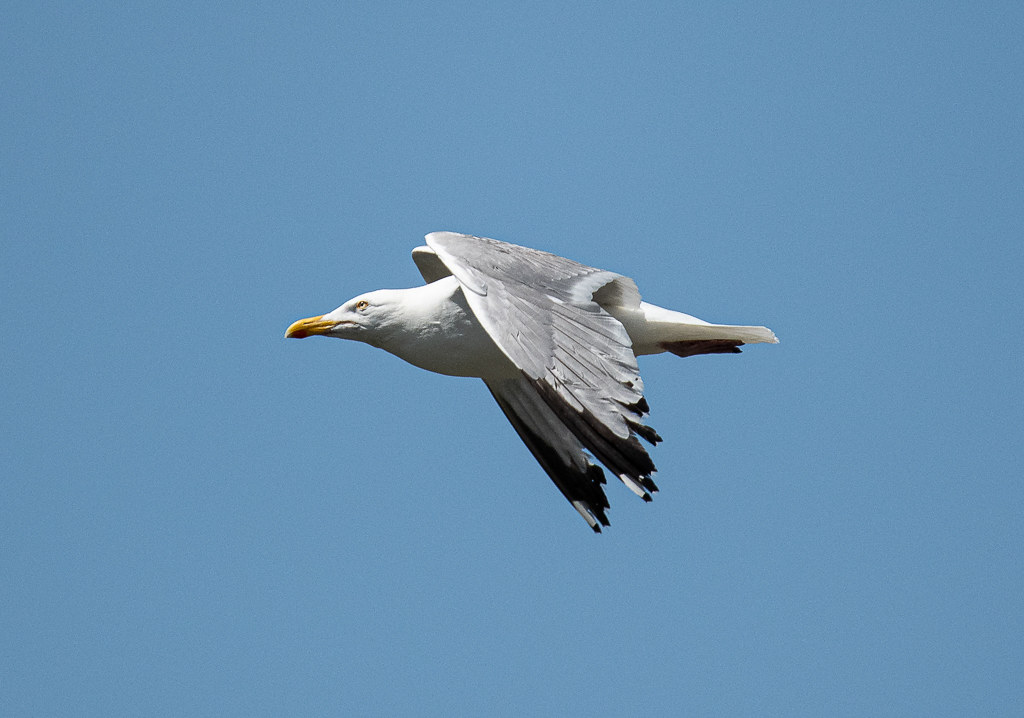 BirdPics- by Martin H, on Flickr
BirdPics- by Martin H, on Flickr
 BirdPics--4 by Martin H, on Flickr
BirdPics--4 by Martin H, on Flickr BirdPics--3 by Martin H, on Flickr
BirdPics--3 by Martin H, on Flickr BirdPics--2 by Martin H, on Flickr
BirdPics--2 by Martin H, on Flickr BirdPics- by Martin H, on Flickr
BirdPics- by Martin H, on Flickr BirdPics- by Martin H, on Flickr
BirdPics- by Martin H, on Flickr
Last edited:
sk66
Advertiser
- Messages
- 8,716
- Name
- Steven
- Edit My Images
- Yes
Yes, the two combined... highlight weighted metering reducing the ISO.No, you were right the first time. Highlight weighted metering is there to prevent highlights being burnt out, which was a distinct problem when shooting bright white birds against the sky. I used HWM today and the results were promising and I will be putting a few below shortly, when I've finished editing
There is nothing wrong with a white bird recording as white. And you can't really tell white from clipped; especially in hard/direct light.So here is my second attempts, getting there slowly but as you can see, there are still some burnt out highlight on two of the pictures.

